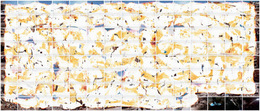 I spent a couple of hours at the Whitney Biennial one recent Sunday afternoon, looking at the art, reading the labels, and watching the crowds. And it was crowded.
I spent a couple of hours at the Whitney Biennial one recent Sunday afternoon, looking at the art, reading the labels, and watching the crowds. And it was crowded.
I was struck, though, by something that I didn’t see in the reviews I read: how much this show focuses on the process of art, rather than the substance. Or maybe the process is the substance. Yes, process has grown in “importance” in contemporary art over the years, but at the Biennial, that’s most of what’s on view — or at least remarked upon. Consider what was written (online, but this parallels the wall labels) about a work by Curtis Mann (above):
Curtis Mann’s photographs contain fragments of scenes that are partially erased and obscured. Mann’s process draws attention to the artifice of the photographic medium by demonstrating the malleability of images. He begins by culling images of strife and conflict in various international locations from photosharing websites such as Flickr and then has prints made. Once he has the prints in hand he covers portions of the photographs with a protective varnish and pours bleach over each one, stripping away areas not coated with varnish.
In After the Dust, Second View (Beirut), Mann has arranged a grid of snapshots of the 2006 war between Israel and Hezbollah….
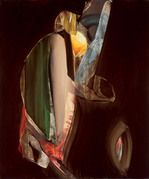 With Pae White, it’s about how she “began creating tapestries with photographic images of crumpled aluminum foil and plumes of smoke.”
With Pae White, it’s about how she “began creating tapestries with photographic images of crumpled aluminum foil and plumes of smoke.”
With James Casebare: “Casebere’s process involves constructing tabletop models out of modest materi¬als, such as Styrofoam, plaster, and cardboard. He then dramatically lights these constructions and care¬fully positions his camera to manipulate the com¬position and the mood of the resulting photograph. Devoid of human figures, the constructions invite viewers to project into and inhabit the space.”
With Lesley Vance: “Lesley Vance carefully arranges and lights objects such as fruits or shells. The artist then photographs these arrangements, and the resulting images serve as the basis for her abstract paintings [above, left]. Vance creates these paintings by manipulating wet paint with a palette knife, erasing and editing her strokes until she feels that the final form has revealed itself.”
When the curators didn’t know what to say about the art, did they revert to talking about process/technique? Looks that way, and while process is interesting, it shouldn’t be everything.
I also noticed that the works that seemed (granted, this was one afternoon) to be attracting the most attention, the longest stays, from Whitney visitors: Stephanie Sinclair’s photographs of Afghani women who had set themselves on fire to escape abuse; Nina Berman’s photographs of a severely disfigured Marine; and the Bruce High Quality Foundation’s “portable museum,” whose installation comments on American culture using video and audio and a hearse/ambulance. Not much about process there.
Photo Credits: Courtesy of the Artists and The Whitney Museum

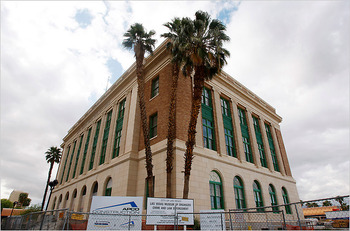
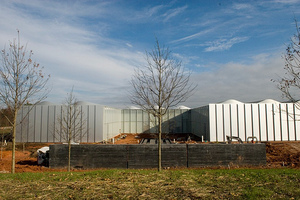
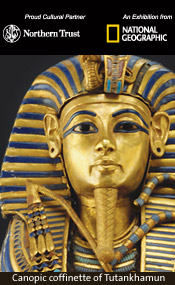 And he did have discussions, a few years ago, with Philippe de Montebello, then director of the Met. They could not agree on the costs/fees, and the Met stood down. That’s what Hawass said on Wednesday at the press briefing.
And he did have discussions, a few years ago, with Philippe de Montebello, then director of the Met. They could not agree on the costs/fees, and the Met stood down. That’s what Hawass said on Wednesday at the press briefing. 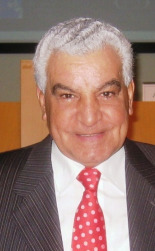 Before going to the press preview this morning for
Before going to the press preview this morning for 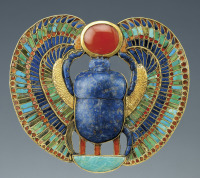 Then, when a Mexican reporter asked why Tut wasn’t going to Mexico City’s archaeological museum — he’d pick up on Hawass’s statement that he wished the exhibition were being held at the Metropolitan Museum, instead in of the grimy, commercial Times Square area — Hawass bluntly told him “you don’t pay anything.” Egypt needs the money from this tour, and the last time Egypt lent something to Mexico, it got beans, essentially.
Then, when a Mexican reporter asked why Tut wasn’t going to Mexico City’s archaeological museum — he’d pick up on Hawass’s statement that he wished the exhibition were being held at the Metropolitan Museum, instead in of the grimy, commercial Times Square area — Hawass bluntly told him “you don’t pay anything.” Egypt needs the money from this tour, and the last time Egypt lent something to Mexico, it got beans, essentially.